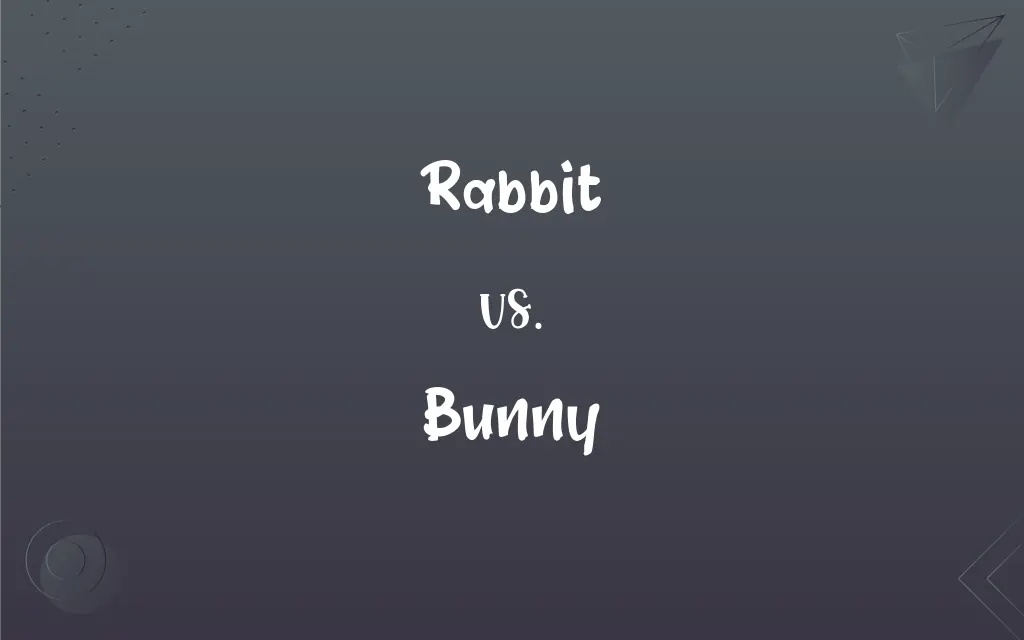Rabbit vs. Bunny: What's the Difference?
Edited by Janet White || By Harlon Moss || Updated on June 10, 2024
Rabbit refers to a small mammal with long ears, while bunny is an informal and endearing term often used for a young rabbit.

Key Differences
Rabbits signify a broad range of species in the family Leporidae, characterized by their long ears and robust back legs. The term rabbit is a universal nomenclature that refers to numerous species across various regions, embracing both domestic and wild variants. On the other hand, bunny has a somewhat snug and amicable connotation, often finding its use in colloquial English to particularly indicate a cute, cuddly, or young rabbit, with a slight, implicit connotation of warmth and fondness.
The rabbit, in various cultures and narratives, symbolizes fertility and vitality, given their high reproductive capabilities and prolific breeding. This symbol has entrenched itself in numerous cultural and religious narratives worldwide, emphasizing the rabbit’s role in various allegorical contexts. The bunny, however, often symbolizes innocence, sweetness, and the Easter holiday in certain cultures, perhaps attributed to its diminutive and adorable depiction in popular media and literature.
A scientific and formal document or research about these mammals will predominantly utilize the term "rabbit," reflecting a more accurate and universal taxonomy and nomenclature. Bunny, however, often appears in informal contexts, children’s literature, and in daily conversation, where scientific accuracy is not stringent, allowing for a more affectionate term to prevail.
It is noteworthy that rabbits have played a crucial role in biotechnology and scientific research due to their reproductive nature and physiological characteristics. Bunnies, conversely, predominantly carve their niche within the commercial, pet, and entertainment industry, where their adorability and gentleness are marketed and celebrated.
The usage of rabbit and bunny also diverges linguistically and geographically. While "rabbit" is widely recognized and utilized globally, "bunny" has a strong presence in American English, rendering it commonly used in the United States and its cultural derivatives. Both terms, while overlapping, portray the creature under different lights and contexts, encapsulating both its biological and cultural facets.
ADVERTISEMENT
Comparison Chart
Formality
Formal and scientifically accurate.
Informal and colloquial.
Context
Used in scientific and general contexts.
Often used in casual, child-friendly contexts.
Connotation
Neutral, can refer to any age or type.
Suggests youthfulness or cuteness.
Cultural Symbolism
Represents fertility and vitality.
Associated with sweetness and Easter.
Use in Literature
Appears in a wide range of literature.
Common in children's literature.
ADVERTISEMENT
Rabbit and Bunny Definitions
Rabbit
The rabbit, symbolizing fertility in various cultures, is renowned for its high reproductive capability.
During spring, the population of rabbits in the wild significantly increases.
Bunny
Bunny is commonly used as a term of endearment.
You're my little bunny, she whispered to her daughter.
Rabbit
In textile industries, “rabbit” often relates to the animal’s fur, utilized in clothing.
The vintage coat, made of rabbit fur, was a luxury item in its time.
Bunny
A bunny is often a young, fluffy, and small rabbit.
The child gently cradled the tiny bunny in her arms.
Rabbit
Rabbits can be wild or domesticated, with numerous species and breeds.
Domestic rabbits can vary greatly in size and color, depending on the breed.
Bunny
Bunny can denote a character or icon designed to be cute and appealing.
The animated bunny twitched its nose adorably in the cartoon.
Rabbit
In culinary contexts, a rabbit refers to the animal as a source of meat.
The recipe called for rabbit meat, which is lean and subtly flavored.
Bunny
The word bunny is associated with certain cultural symbols, like the Easter Bunny.
Every Easter, children look forward to receiving chocolates from the Easter Bunny.
Rabbit
A rabbit is a burrowing mammal with distinct long ears and powerful hind legs.
The rabbit quickly sprinted across the field to avoid the predator.
Bunny
The term bunny is predominantly utilized in American English and might not be as widely used in other English dialects.
In the USA, bunny is commonly used to describe a cute rabbit, especially in children’s language.
Rabbit
Any of various long-eared, short-tailed, burrowing mammals of the family Leporidae, such as the commonly domesticated species Oryctolagus cuniculus, native to Europe and widely introduced elsewhere, or the cottontail of the Americas.
Bunny
A rabbit, especially a young one.
FAQs
How is "bunny" typically used in cultural symbolism?
Bunnies are often associated with sweetness, innocence, and the Easter holiday.
What does "rabbit" refer to?
A rabbit refers to a small, burrowing mammal with long ears and powerful hind legs.
Can "rabbit" and "bunny" be used interchangeably?
While they can be used interchangeably in casual conversation, "rabbit" is the formal term.
Is "bunny" a scientific term?
No, "bunny" is an informal, colloquial term often used to describe young or cute rabbits.
What does the term "rabbit" symbolize culturally?
Rabbits often symbolize fertility, vitality, and rebirth in various cultures.
Do both rabbits and bunnies feature in folklore and mythology?
Yes, both often appear in folklore and myths, sometimes as trickster figures or symbols of prosperity.
What is a notable cultural icon involving bunnies?
The Easter Bunny is a notable icon, symbolizing a bringer of eggs and candy during Easter.
Are bunnies often depicted in children's literature?
Yes, bunnies are frequent characters in children’s literature due to their cute and gentle image.
Are bunnies considered good pets for children?
Bunnies are popular pets but require careful handling and care, which might be challenging for young children.
Are rabbits and bunnies the same animals?
Essentially yes, but "bunny" is often used to describe a young or adorable rabbit.
Is "bunny" utilized globally?
"Bunny" is commonly used in American English and might be less prevalent in other English dialects.
Why might someone use "bunny" instead of "rabbit"?
“Bunny” might be used for its affectionate connotations or to specifically denote young rabbits.
Do rabbits live in the wild and domestic settings?
Yes, rabbits can be found in wild environments and are also kept as pets.
What is the lifespan of a rabbit?
Rabbits typically live between 8 to 12 years, depending on breed and care.
Is "bunny" ever used in adult contexts?
Yes, "bunny" can be used as a term of endearment among adults or in certain cultural contexts (e.g., Playboy Bunnies).
What is the context where “rabbit” is most appropriate?
“Rabbit” is most appropriate in scientific, formal, and general contexts.
What are young rabbits officially called?
Young rabbits are scientifically referred to as "kittens" or "kits."
Are rabbits and hares the same?
While similar and related, rabbits and hares are distinct species with noticeable differences in size, life cycle, and behavior.
Are rabbits herbivorous?
Yes, rabbits primarily consume a diet of plants.
What is rabbit fur used for?
Rabbit fur can be used in the textile industry for garments like coats or accessories.
About Author
Written by
Harlon MossHarlon is a seasoned quality moderator and accomplished content writer for Difference Wiki. An alumnus of the prestigious University of California, he earned his degree in Computer Science. Leveraging his academic background, Harlon brings a meticulous and informed perspective to his work, ensuring content accuracy and excellence.
Edited by
Janet WhiteJanet White has been an esteemed writer and blogger for Difference Wiki. Holding a Master's degree in Science and Medical Journalism from the prestigious Boston University, she has consistently demonstrated her expertise and passion for her field. When she's not immersed in her work, Janet relishes her time exercising, delving into a good book, and cherishing moments with friends and family.































































